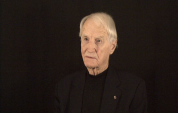6:45 | Tom Cash recounts the heart wrenching losses suffered in the Hurtgen Forest. In one day, his unit was reduced to less than a fourth of its strength. Many were killed with a baiting tactic involving tracer bullets. Then it was close combat, with bayonets and grenades.
Keywords : Tom Cash Hurtgen Forest grazing fire tracer bayonet grenade snow replacement German K-ration

Coming from a country farm and a one room schoolhouse, Tom Cash was drafted into the Army and landed on Utah beach a few weeks after the big invasion. He was picked by his sergeant to become a mortarman as they started their advance inland. He recalls an incident in which three hysterical soldiers were turned around and sent back to the front.
Mortarman Tom Cash recalls when his sergeant sliced his backpack right off of him and told him he would just be carrying a mortar and ammunition. Battling German SS troops all the way, his unit advanced to Saint-Lo, where it suffered casualties from friendly Allied bombing.
After his unit participated in the liberation of Paris, they called in air support to strike retreating Germans. Tom Cash describes that devastating attack and then the move to the Siegfried Line with it's imposing defenses.
He slept in a cold foxhole most of the time. Tom Cash was near the Siegfried Line in the Hurtgen Forest, where the fighting was fierce. A tree burst from German artillery stuck down his sergeant and soon he was wounded as well.
Tom Cash learned the techniques of mortar targeting in basic training, but in combat, they were quickly modified. The mortermen in his unit were so efficient in firing that captured German soldiers were asking to see the automatic mortar. Once he was given a riskier task, night patrol behind enemy lines.
Wounded in the Hurtgen Forest, Tom Cash was sent to Miami for rehabilitation. Then it was on to Texas where he trained inductees, sharing insights gained in his recent combat. After one last assignment at the chemical warfare school, he finally had enough points for discharge.